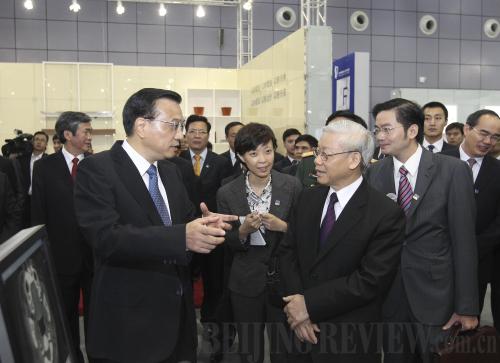|
 |
|
HI-TECH INTEREST: General Secretary of the Central Committee of the Communist Party of Viet Nam Nguyen Phu Trong (front right) visits the Zhongguancun technology hub in Beijing on October 12, accompanied by Chinese Vice Premier Li Keqiang (front left) (DING LIN) |
The marine economy accounts for about 30 percent of Viet Nam's GDP, Zhang said. Viet Nam has recently released a sea strategy with a focus on developing marine resources.
"As it deepens economic reliance on the sea, Viet Nam will give greater prominence to maritime rights and interests," Zhang said. "For China, the South China Sea issue concerns its sovereignty. Both countries will therefore adopt a prudent attitude toward this issue. It is unlikely for them to make any substantive compromises."
During a visit to Singapore, Malaysia and Indonesia in mid-October, Japanese Foreign Minister Koichiro Gemba proposed putting the South China Sea issue under multilateral discussions.
In response, China expressed its objection. It will only make the issue even more complicated to put it under multilateral discussions, Liu said.
The issue should be solved through negotiations between countries directly concerned. This is a consensus reached in the Declaration on Conduct of Parties in the South China Sea signed between China and the Association of Southeast Asian Nations in 2002, he said.
China hopes countries outside the region can do things helpful for peace and stability in the South China Sea and support the efforts made by countries in the region to solve the issue through consultations and negotiations.
Economic and trade cooperation between China and Viet Nam has witnessed rapid development in recent years, said Chu.
China has been the largest trade partner of Viet Nam for seven consecutive years from 2004 to 2010. Statistics from China's Ministry of Commerce show trade between China and Viet Nam reached $30.1 billion in 2010. In the first eight months of 2011, two-way trade hit $24.9 billion, up 39.9 percent over the same period last year.
China is willing to work with Viet Nam to further expand cooperation based on mutual respect, equality and mutual benefit, said Chinese Premier Wen Jiabao while meeting with Trong in Beijing.
The two sides should focus on implementing their five-year trade and economic cooperation plan for 2012-16 signed during Trong's visit. They should promote balanced and sustained trade growth, encourage mutual investment, advance the development of economic cooperation zones and expand cooperation between border provinces, Wen said.
Trong agreed with Wen and said strengthening trade and economic cooperation is in the common interests of both countries.
Despite thriving trade cooperation, two major problems exist, Chu said. First, Viet Nam is dissatisfied with its big trade deficit with China. Official Chinese statistics show China's exports to Viet Nam exceeded $23 billion in 2010, while its imports from Viet Nam were less than $7 billion.
The other problem is Viet Nam believes China's investment in Viet Nam is too small. By the end of 2010, China's direct investment in Viet Nam totaled $986.6 million, as opposed to $6.1 billion in Singapore and $1.9 billion in Myanmar, the top two destinations for Chinese investors in Southeast Asia, according to the 2010 Statistical Bulletin of China's Outward Foreign Direct Investment issued by China's Ministry of Commerce.
During the visit, Trong showed an intense interest in technological cooperation, as evidenced by his visit to the Zhongguancun technology hub in Beijing.
The two countries have great potential in hi-tech cooperation and Viet Nam expects to strengthen such cooperation with China, Trong said.
While staying in Guangdong, he visited a number of hi-tech enterprises including China's leading telecom equipment makers, Huawei Technologies and ZTE Corp.
To develop the hi-tech industry is one of Viet Nam's 2011 economic and social development goals. Previously, Viet Nam had attempted to acquire technology from the United States and Europe, but it didn't work out. Now Viet Nam has shifted its focus to China, said Chu.
For instance, Viet Nam has sent several science and technology delegations to China's Guangxi Zhuang Autonomous Region, which borders Viet Nam, in recent years. The delegations studied Guangxi's information technology, straw utilization technology, modern agricultural park construction and water-saving irrigation.
Guangxi also sent a delegation to the technology equipment exhibition in Viet Nam's Quang Ninh Province last year. And a number of concrete technological cooperation projects have been carried out between the two sides. | 